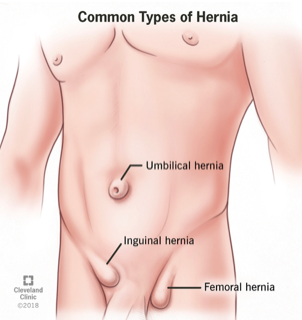This article has been verified medically by Dr Melvin Look, consultant surgeon at Surgi-TEN Specialists, Farrer Park Hospital (Singapore).
About the Doctor
Strong layers of tissue and muscle protect your organs. However, when there is a weak spot in connective tissue called fascia, organs and fatty tissue could slip through and create a bulge, giving rise to hernias.
Causes, symptoms and diagnosis
Hernias can be caused by several factors, including poor nutrition, pregnancy, persistent coughing and sneezing, smoking, obesity and heavy lifting without proper support. In addition to being visually disconcerting, the protrusion may also cause pain, burning sensations and uncomfortable pressure. These symptoms may feel worse while doing strenuous activities such as lifting, running, or passing stool.

Hernias occur when tissues protrude from weak points in your abdominal wall.
Image: Cleveland Clinic
There are many forms of hernias, with about three out of four occurring in the groin region. Groin hernias fall into two categories:
- Inguinal hernias are the most common, affecting more men than women. These occur when tissue, organs or your intestine slip through weak spots around your inguinal canal located in your lower abdominal wall.
- Femoral hernias, which occur along the femoral canal, tend to affect older women and happen when fatty tissue or a part of the intestine protrudes around the upper inner thigh.
Other hernias one might experience include:
- Incisional hernias that occur around the site of an operation.
- Epigastric hernias around the lower sternum region.
- Umbilical hernias near the belly button. This affects about 10–20 per cent of newborns but should resolve spontaneously by the time the child turns five.
- Hiatal hernias. Bulges may not be present but patients may experience symptoms such as heartburn, indigestion, regurgitation and difficulty swallowing.
To make a hernia diagnosis, doctors will do a physical examination and may follow up with ultrasound scans.
Treating hernias
When hernias are small, you may be able to push in the bulge while lying down. However, as the swelling tends to get larger over time and cause issues, early treatment is advised for better success and recovery. Hernias typically do not go away on their own and the most common way to treat them is with surgery.
Resolving hernias will improve comfort as well as prevent problems and complications including vomiting, bowel obstruction or severe pain. Strangulation of blood supply to hernia tissue is also considered a medical emergency that can be life-threatening as it causes neurogenic shock and can cause toxic reactions that deteriorate your health. Symptoms of a strangulated hernia include vomiting and nausea, fever, acute pain, a bulge that is red, purple or dark-coloured, and not being able to pass stools or gas.
Hernia surgery
If surgery is needed, the common techniques are laparoscopic surgery by keyhole method, or open surgery. During surgery, a flexible hernia mesh is usually inserted to reduce hernia recurrence.





















